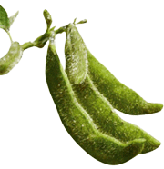The world upside down: Police protection for agrarian reform officials in Canindeyu
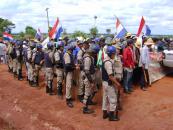 Police protection for INDERT officials, 21-01-0921 January 2009 - Colonia San Juan, Puente Kyjha, Canindeyu
Police protection for INDERT officials, 21-01-0921 January 2009 - Colonia San Juan, Puente Kyjha, Canindeyu
Close to the border with Brazil, in the province of Canindeyu, it is ‘sojalandia a full’, or let’s say one of the heartlands of soy devastation. This complete transformation to an industrial agriculture zone has occurred in a time span of only about 10 years.
As in many other places in Paraguay, the regional land reform institution (INDERT) was until recently thoroughly corrupt. Many plots of land were first assigned to landless families, but later these same plots were resold to Brazilian soy farmers. This was also the case in the Colonia San Juan, near the town of Puente Kyjha. In this community, 8000 hectares of land were assigned to landless families, but after 6 months they were violently evicted as the land was resold to latifundistas.
Since then, this community, organised in the Federación Nacional Campesino (FNC), has fought to reclaim the land. But their claim they had to reduce to only 2000 of the original 8000 hectares, because only of can be proven to be ‘malhabida’ and this is the land now claimed.
With the change of government, this finally seemed to succeed. On January 14, INDERT came to assess the situation, to verify which land belonged to who, and which land should be taken back and reassign them to the 200 landless FNC families living in the area. The INDERT officials were assaulted by the soy farmers, hitting the van and trying to push around INDERT official Alberto Romero. INDERT had to stop and the work was postponed.
Newspaper Ultima Hora relates how hunderds of campesinos, who are now based in the San Roque school of Colonia San Juan, were separated from an angry crowd of land owners by the police force. Spokesperson (on purpose?) was one of the smaller land owners (18 hectares), who made the bloodspill threat. On this threat, INDERT reacted by calling a halt to the meeting, and started verifying the first plots of land, protected by a heavy security force. However, they did not get further than verifying 6 out of 163 plots of land.
Soy farmers threathen with ‘bloodspill’
After this first visit, soy farmers predicted a ‘blood spill’ as soon as INDERT officials would actually hand over land parcels to families sin tierra. In addition, lawyer Eduardo Bernal made an official complaint against the president of INDERT, Alberto Alderete, not not respecting land titles held by “varios campesinos” in this area and for “invading properties”.
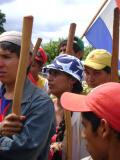 FNC mobilisation
FNC mobilisation
The FNC responded by mobilising their bases in order to accompany the INDERT on the next occasion. The FNC has initiated a more general campaign against the "sojización".
On Monday 19 January, an assembly of the FNC in Colonia San Juan decided to give Brazilian soy farmers one month, until the 20th of February, to harvest their soy and leave the land. They also announced that the people that will be assigned a plot of land, will camp out on that land until the soy is harvested.
On Wednesday 21 January, INDERT came back to colonia San Juan protected by 100 policemen to start work again. A very unusual sight in Paraguay, where military and police repression of small farmer movements is historical, and has not ended with this government. A delegation of human rights and environmental organisations travelled to Colonia San Juan to accompany the work of INDERT and to support the FNC.
INDERT has now announced that soy farmers have until mid february to harvest what is growing on these plots, and then have to leave. The work is complicated, as there are also small producers that have more than one plot, which is not allowed. The real problem is those that have ten plots or more. Various soy fields had new little houses built right in them, in order to prove that they are ‘inhabited’ and to get compensation money for ‘improvements’ to the land should they be disowned. Otherwise, those that loose land, do not receive any compensation, and even have to pay rent over the years they have occupied the land, and for the damage done to it.
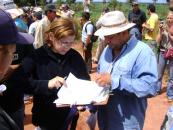 INDERT officials checking land titles
INDERT officials checking land titles
History of colonia San Juan, Canindeyu
"Preferemos morir en la calle luchando que en la casa envenenados", Arnilda Chaparro
Arnilda Chaparro and Eliodoro Centurión have been members of the community from the first hour. They relate how in 1994-1995, landless people were assigned land in this area, which was then still all forest. In the forest, they built houses and made space to cultivate crops. They got no support from the government or anyone else.
However, after 6 months they were evicted as the INDERT had resold the land to Brazilian soy farmers, and there was a court order to evict them. One compañero got killed. He was – not accidentally – driven over by a van, a typical contracted murder. Everything was destroyed, even the school.
Part of the first settlers came back to occupy the land again. But over the years, many had to leave due to economical problems, and sold their plots to soy farmers or neighbours. At first, prices paid to those who left were only 9 million guaranies (about 1500 euro) for 10 (!) hectares of land. Especially around 2003-2004, many people left, about 3 to 4 families per day.
The soy farmers tried to get the remaining families into soy farming, but according to Chaparro and Centurión, this was only propaganda. Meanwhile, it was becoming impossible to produce food crops next to soy fields, because of the fumigations.
A nearby indigenous community, Takuatú, is completely surrounded by soy. Soy farmers coopted their leader and built him a nice house, and now 70% of the 1000 hectares they had, is covered with soy.
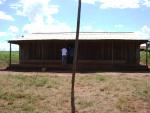 Abandoned school surrounded by soy fields in colonia San Juan
Abandoned school surrounded by soy fields in colonia San Juan
Schools in the area are being closed, because the number of students has gone down drastically because of families leaving the land.
